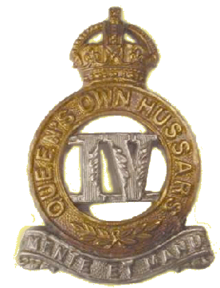4th (Queen's Own) Hussars
| 4th Queen's Own Hussars | |
|---|---|

Crest of the 4th Queen's Own Hussars
|
|
| Active | 1685 - 1958 |
| Country |
|
| Branch |
|
| Type | Cavalry of the Line/Royal Armoured Corps |
| Role | Light Cavalry |
| Size | Regiment |
| Part of | Royal Armoured Corps |
| Nickname(s) | Paget's Irregular Horse |
| Motto(s) | Mente et Manu (With Mind and Hand) |
| March | Quick: Berkeley's Dragoons Slow: Litany of Loretto |
| Anniversaries |
Salamanca Day, 22 July Balaklava Day, 25 October St Patrick's Day, 17 March |
| Commanders | |
| Colonel-in-Chief | Sir Winston Churchill |
The 4th Queen's Own Hussars was a cavalry regiment in the British Army, first raised in 1685. It saw service for three centuries, including the First World War and the Second World War. It amalgamated with the 8th King's Royal Irish Hussars, to form the Queen's Royal Irish Hussars in 1958.
The regiment was first raised by the Hon. John Berkeley as The Princess Anne of Denmark's Regiment of Dragoons in 1685, as part of the response to the Monmouth Rebellion by the regimenting of various independent troops, and ranked as the 4th Dragoons. The regiment transferred its allegiance to King William III in February 1689 and fought the depleted forces of James II in Scotland in later that year. The regiment saw action at the Battle of Steenkerque, where it suffered heavy losses, in August 1692 and at the Siege of Namur in July 1695 during the Nine Years' War. The regiment suffered heavy losses again at the Battle of Almansa in April 1707 during the War of the Spanish Succession and next fought at the Battle of Sheriffmuir in November 1715 during the Jacobite rising.
The regiment saw action at the Battle of Dettingen in June 1743, when Trooper George Daraugh bravely recovered the regimental standard that had been seized by a French officer during the War of the Austrian Succession. The regiment suffered a serious reverse when it was ambushed during a series of disastrous events leading up to Fall of Ghent in July 1745 and then fought bravely to mitigate the British defeat at the Battle of Lauffeld in July 1747. The regiment was formally titled as the 4th Regiment of Dragoons in 1751 and, having helped suppress the Gordon Riots in 1780, it was named for Queen Charlotte as the 4th (Queen's Own) Regiment of Dragoons in 1788.
...
Wikipedia
